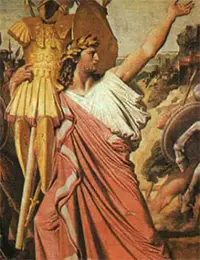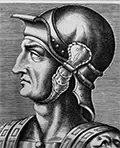Ancient Rome: the Seven Kings
Roman tradition has it that the ruling the city from its earliest days, long before the Roman Republic and the Roman Empire, were a series of seven kings. For more than 250 years, these kings ruled Rome. A period of time known as an interregnum elapsed between the reigns. 
No matter how it came to be, Romulus is generally regarded as the first of the ancient kings of Rome. The founding of the city is often stated as happening in 753 B.C. Romulus expanded the borders of the city, incorporating the Caelian and Quirinal hills. (His choice for the first hill on which to build was the Capitoline; the choice of his brother, Remus, was the Aventine.) 
The early city had a large number of men but few women, and so Romulus created the festival of Consus, to which he invited the members of a number of neighboring tribes. While the festival was still going on, a number of Roman men forced into marriage a number of unmarried Sabine women. This came to be known as the Abduction of the Sabine Women. Not surprisingly, Titus Tatius, the Sabine king, sought revenge. 
The Sabines gained a bit of high ground in that they captured the Capitoline hill. Tatius and Romulus brokered a truce that saw the two ruling Rome jointly, with Tatius ruling from atop the Capitoline hill and Romulus having his headquarters on the Palatine hill. When Tatius died, Romulus regained sole control of Rome. Romulus presided over a violent era. He was said to have slain the king of the Caeninenses in single combat, sealing a Roman victory. One story of Romulus's end is that he was killed by a group of disgruntled nobles. 
Following Romulus on the throne of Rome was Numa Pompilius, the son-in-law of Tatius. The Senate elected him king, and his reign was peaceful compared to that of Romulus. During his reign came the founding of the Temple of Janus and the import of the Vestal Virgins, from Alba Longa. This king is also said to have added the months of January and February to the calendar so as to make a year have 360 days. Numa died in 673 B.C. 
Not much is known about these early kings. The names of the Seven Ancient Kings of Rome, however, are known. Following Numa Pompilius was Tullus Hostilius, who is generally credited with overseeing the construction of the first building dedicated entirely to the Senate, known for a few centuries as the Curia Hostilia. More of a military man like Romulus, Tullus started wars with several of Rome's neighbors, including Alba Longa and the Sabines. Tullus is said to have died from a lightning strike. 
Next on the throne was Ancus Marcius, who prosecuted war with the Latins and the Veientes, added Janiculum to the city boundaries and implementing transport by a bridge across the Tiber, and oversaw the construction of the city's largest port, Ostia. Some sources say that this king ordered built the Mamertine prison, the city's first. When Ancus Marcius died, the next to be king was Lucius Tarquinius Priscus, also known as Tarquin the Elder. The first Etruscan king of Rome, he proved himself an able defender of Rome when its neighbors sought to take advantage of a change in leadership, fighting off attacks from the Latins and the Sabines. This king is credited with the construction of the Circus Maximus, the temple of Jupiter Optimus Maximus, and the Coaca Maxima (a large sewer). Tarquin also married a woman Servius proved adept at fighting, defeating the Veii and other neighbors. He is said to This second Tarquin was the last king of Ancient Rome. The Etruscan proved extremely violent in his approach to Tarquin spent the next 13 years trying to regain his throne, raising armed forces here and there. After losing yet again, at the Battle of Lake Regillus in 496 B.C., he fled to Cumae, where he died the following year. |
|
Social Studies for Kids
copyright 2002–2024
David White



 named Tanequil, who, when her husband was assassinated, assured the people of Rome that he was only wounded and, in the ensuing confusion, ensured that the next king would be Servius Tullius, whom most sources say was the son of one of the queen's slaves. Tanequil it also was who interpreted as a good omen the set of events that saw, on their entry into Rome, an eagle take Tarquin's hat from his head and then return it.
named Tanequil, who, when her husband was assassinated, assured the people of Rome that he was only wounded and, in the ensuing confusion, ensured that the next king would be Servius Tullius, whom most sources say was the son of one of the queen's slaves. Tanequil it also was who interpreted as a good omen the set of events that saw, on their entry into Rome, an eagle take Tarquin's hat from his head and then return it. have introduced coinage to replace barter, with a monetary system based on an ingot of raw copper, and to have introduced the first census, with the population ending up divided by age, status, and wealth. He made enemies of the Senate, however, and was the victim of assassination at the hands or direction of Lucius Tarquinius Superbus, whose grandfather was the former king Tarquin the Elder.
have introduced coinage to replace barter, with a monetary system based on an ingot of raw copper, and to have introduced the first census, with the population ending up divided by age, status, and wealth. He made enemies of the Senate, however, and was the victim of assassination at the hands or direction of Lucius Tarquinius Superbus, whose grandfather was the former king Tarquin the Elder. maintaining his power, keeping his enemies off-balance by declaring himself the chief judge of the city. He initiated wars with a handful of neighbors, including the Rutulie and the Volsci. An uprising toppled the king, forcing him into exile after losing the Battle of Silva Arsia in 509 B.C. At this point, Rome declared itself rid of him and set up
maintaining his power, keeping his enemies off-balance by declaring himself the chief judge of the city. He initiated wars with a handful of neighbors, including the Rutulie and the Volsci. An uprising toppled the king, forcing him into exile after losing the Battle of Silva Arsia in 509 B.C. At this point, Rome declared itself rid of him and set up 
